Processing Lampreys (2016) is a multi-media essay published in Crtl-Z: Journal of Media Philosophy
Processing/Lampreys:
Photo-Fiction as Digital Parasite Aesthetics
By Yvette Granata
From ‘Photo of Lamprey’ to ‘Photo-Fictional Lamprey’
‘The lamprey’ is the name given to any fish of the order Petromyzontiformes. It is most commonly known as a parasitic, jawless fish that latches its fanged mouth onto other fish in order to suck the blood of its host. A google search of ‘lamprey’ brings up a series of digital photographs that show its ‘toothed, funnel-like sucking mouth’ prominently featured in the results. When asked, via the search field, what a lamprey is, then, google also answers the question, ‘what does a lamprey look like?’. It responds to us, ‘Here is a photo of a lamprey’ and ‘here is a photo of many lampreys’ and ‘this is what a lamprey looks like’. The toothed, sucking mouth is both the image of and the encounter with the lamprey.
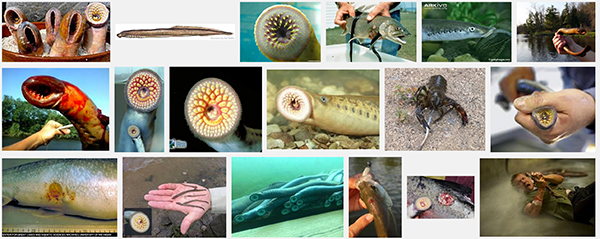
Yvette Granata, Google Image Search Results, ‘Lamprey’ (2016). Screenshot.
Google’s search results in this way present to us a theoretical position on both the lamprey and on photography. Like Walter Benjamin’s optical unconscious, google image search returns photographs of the lamprey as if to reveal lamprey mouths and teeth that we perhaps have never seen, the real lamprey in photographic stillness. For Benjamin, the camera revealed the unseen, whereby the photographic offered an indexical print of reality through the capture of the surfaces of objects. This ‘unseen’ was embedded in the experience of daily life, and the technology of the camera showed us what we did not see in our daily experience, ‘with all its resources for swooping and rising, disrupting and isolating, stretching or compressing a sequence, enlarging or reducing an object. It is through the camera that we first discover the optical unconscious’ (Benjamin, ‘Little History’, 512). Through the photograph, and through the image search engine, the objects that we have never seen are shown to us.
Yvette Granata, WhatIsALamprey? (2016). Video.
The photograph of the lamprey that google presents is an image of an animal body and of its fangs. It is a snapshot of an animal-object as parasite that threatens to latch upon the viewer. The image of the lamprey as an image of ‘the parasite’ reveals that the parasitic is classed by the human as a negative, rather than an essential characteristic for survival. The search results do not show, for example, an array of perspectives of the lamprey in its context, but images of fangs, jaw-less toothed mouths, bites, blood. It is a critique of the parasite, or a definition of the parasite as what it might do to us, a threat-mouth object, a thing that will suck on you.
A corollary to Roland Barthes’ myth, in which something is always ‘added to’ the sign, the ‘photo of’ the lamprey is an amplification of lamprey teeth. It produces a mythic threat by centering the lamprey teeth. Through this ‘photograph of’ the lamprey, a reduction of a species also occurs: lamprey = parasite = teeth. While the objectifying gaze of the camera and the politics of its images have been thoroughly critiqued since the invention of photography, and while the invention of digital photography and software editing practices have pushed contemporary critique beyond an analysis of the material of the index, there nonetheless remains a particular phrase that lingers in the everyday use of media—the ‘photograph of’, the ‘image search for the photograph of’.
In his work on non-photography and photo-fiction, François Laruelle gives a method for moving away from this phrase. Instead of the photograph of an object, photo-fiction ‘is about rendering the photographic act immanent, of interiorizing it, and rendering it real without an external realism, of destroying philosophical and perceptual sufficiency without denying the necessity for perception’ (Laurelle, Photo-Fiction, 7). One of the main tenets of Laruelle’s thought is a critique of philosophy’s separation of thought and immanence. He claims that by thinking about immanence, philosophy has always separated itself from it, calling out philosophy’s auto-position to make claims about immanence or the Real.
The auto-position of philosophy, or the self-assignment of its authoritative position, is what allows philosophy to legitimate itself (decisionism). What Laruelle attempts to construct instead is thus a method for thinking with immanence and not about it. Similar to his critique of philosophical decisionism overall, whereby he exposes philosophy’s proclivity to pathologically conflate thought with representational access to the Real, with photo-fiction Laruelle gives the method for looking at the photographic process as its own proclivity to expose and render itself, as opposed to its captured object.
Following Laruelle’s line of thought, then, the photographic image is merely the mimesis of its technological prerogative—the process of capturing light bouncing off of objects—not the revelation of objects. The camera captures light particles, and gives us in turn, an artifact of its internal image—the photographed. The photographer who ‘captures’ the world—Laruelle posits—is working within a ‘photographic finitude’ in which ‘finitude does not mean the reception of an external given, but an impotency in regard to oneself, a powerlessness to leave oneself so as to go amongst things or—a vision condemned to see according to itself’ (Concept, 15). He goes on to suggest that ‘this stance consists less in situating oneself in relation to the World…than in definitely abstracting oneself from it, in recognizing oneself from the start as distant, as the precessor’ (Concept, 15). The photographer is not unaware of this, but works within naiveté and accepts the a priori position of a separation between subject/object—the precess of the subject—thus agreeing to stand apart from the world.
Like photography, we may also view Google’s image search as bolstering this notion, replicating a similar photographic precessing of images through the internal prerogative of its search algorithm. It makes a claim on the ‘real lamprey’ by accepting the position of its function, assuming its ability to find and retrieve an image object as the same as presenting the realness of an animal. It likewise conflates the animal in the world with its act of returning to us the range of lamprey teeth out there on the internet. The result is produced merely from an acceptance of the naiveté of its own technological operation.
Neither photography nor Google give us a mimicry of a lamprey. They do not reveal an internal operation similar to the lamprey. They do not mimic that which they show nor do what the parasite does, thereby making us understand a parasitic process. By comparing the notion of being shown a parasite versus doing what a parasite does, we can better understand photography as its position, its precess. Moving away from the prerogative of photography then, we might ask—what is a photo-fictional lamprey?
Processing as a Photo-fictional Parasite
The animation project Processing/Lampreys is a series of animated lamprey surfaces, structures, movements, and terrains crafted from digital images of lampreys made with the Processing coding language, Javascript, and After Effects. It looks to Laruelle’s notion of photo-fiction as a different realism of photography—realism not as an overdetermined representation, but as an ‘under-determined chaos’ in which the camera is one variable within a fusion of variables. It aims to create a method of photo-fictional chaos through image processing that crafts new worlds from the digital data of lamprey images in order to produce an under-determined chaos.

Yvette Granata, Processing sketch (running) (2016). Screenshot.
While the Processing/Lampreys project induces the digital process of coding as a photographic medium, it begins with an appropriation of lamprey photographs from the google search results. The scripts create 3-D extractions, surface textures, abstract stretchings and motions of the lamprey image, turning the photograph of the lamprey into a digital array. The processing code itself cannot capture light on the surface of a lamprey, the way a camera does. It must be fed digital data from an image’s pixel information; it needs another photograph to latch onto. In this way, image processing code as a photographic medium is necessarily a parasite. For example, with a camera, one need only to push a button and it will work, it will create a photo of anything in front of the camera. With the processing code, on the other hand, if one hits ‘run’ on the program without having the photograph contained within the program data file, the program will fail. It returns the words ‘NullerPointerException’ and tells you ‘the file is missing’.

Yvette Granata, Processing sketch failure (2016). Screenshot.
The program code and the effect scripts are selective of their hosts. Just as a lamprey cannot suck on a twig or a cardboard box for nourishment but requires animal flesh, the program cannot produce effects with any-object-it-selects-whatsoever. The data is taken from a specific image-object, from a .jpg or .png, and is broken down into more specific data, such as the color data or the position of the pixels, and arranges the data differently. All of the data from the original .jpg or .png is there, but rearranged and redirected according to the operation of the code, its interior process. In this way, the internal technological prerogative of this conceptual camera is similar to a camera; however, it is exactly this internal operation that one works with—its operation constitutes the object.
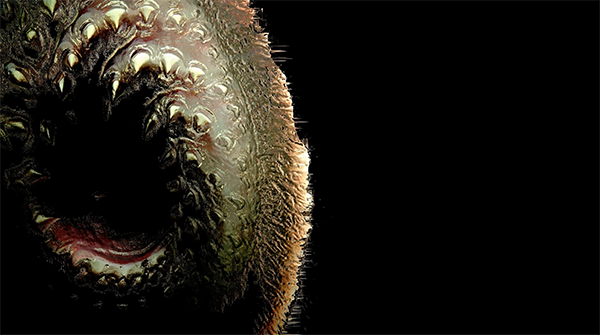
Yvette Granata, Processing/Lampreys (2016). Animation still (Processing/After Effects layered).
Just as the parasite becomes entangled with its host and becomes a part of the host-thing-itself, the ‘image of lamprey’ becomes a part of the process of the technological apparatus. With the lamprey photo as a part of the internal process of the apparatus, this conceptual camera precludes the notion that there is a photographer-subject able to be detached from the world, precessing and rendering the objects in the world for us. Instead there is a host material and a transformation of the material of the host into different types of images and energies, like a parasite-machine. Similar to what Laruelle calls a non-photographic vision, it is an image ‘parallel to the World; a photographic process which has the same contents of representation as those that are in the World, but which enjoys an absolutely different transcendental status’ (Concept, 19). Through the execution of the code and the rendering of effects, the image is no longer recognizable as a lamprey nor as a photo of a lamprey. Instead an alien scenario or scenography emerges, a photo-fiction, as the image process crafts a strange world devoid of a grasped-object, or without a stable representation. It uses the data of the photograph of the lamprey as the source for crafting a realism of an underdetermined world.
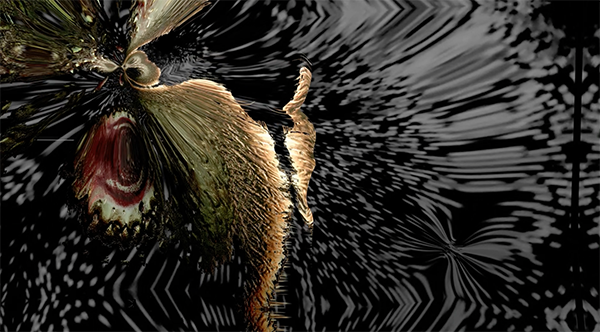
Yvette Granata, Processing/Lampreys (2016). Animation still (Processing/After Effects layered).
In other words, to move from precessing to processing, the lamprey photograph as a photo-fictional scenario moves us away from the ‘showing of’ an object or animal, and instead creates an image of an entangled technological apparatus. This entanglement is a parasite aesthetics.
Towards a Parasite Aesthetics—Or Beyond the Finitude of Photography
Through engaging with coding image processing as a parasitic entanglement, can a post-anthropomorphic image, not of, but with the world emerge?
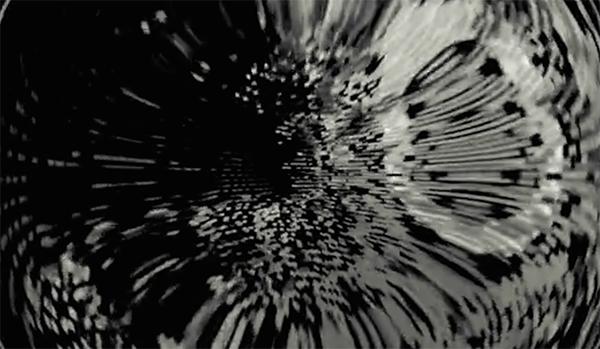
Yvette Granata, Processing/Lampreys (2016). Animation still (Processing/After Effects layered).
With digital image processing, we are more like the lamprey. This is not a negative understanding of, nor a critique of the parasitic, but is a reposition the frame of practices of ‘the parasite’. It is not to say that a parasitic practice is a negative one, but that it is a practice that can apply to the lamprey, the human, and the digital. Parasite aesthetics is therefore not about the formal qualities of images of parasites, nor the representation of the parasitic. It moves away from aesthetic experience ‘of an object’ and moves towards reframing aesthetics as an entangled process.
Parasite aesthetics produces an image of its conceptual-photographic act. It is defined by its modus operandi, like the parasite. The aesthetics are in the practice, in the entanglement of technological operation and the object, not the results. This is another realism of photography, whereby photo-fiction is a replacement for ‘real lampreys’. Photo-fictional lampreys instead grow out of the relation of human worlds, animal worlds, and digital worlds, framing them under the non-negative understanding of the parasitic.
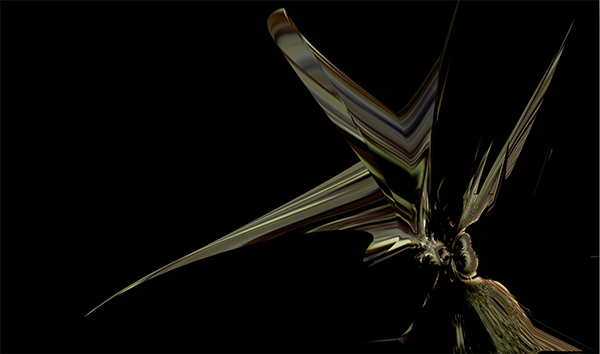
Yvette Granata, Processing/Lampreys (2016). Animation still.
To immanentize photography, one can no longer take a ‘photograph of’, but can only photographize. With a photographized image, we are no longer the human center subject with lamprey animal as a threatening parasite object.
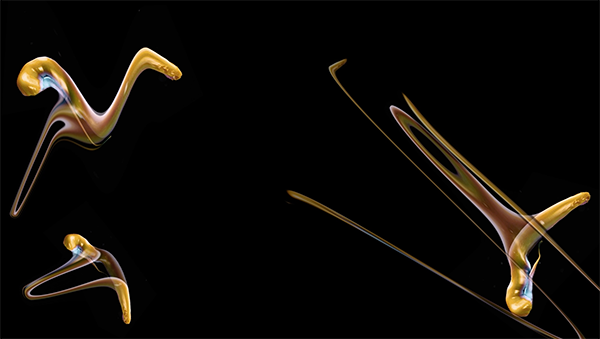
Yvette Granata, Processing/Lampreys (2016). Animation still.
The subject-taking-photo-of-the-object recedes into a de-centered position as one of many variables, a non-positional alterity.
The anthropocentric position is spread out or moved, de-positioned through the digital practice of parasite aesthetics and becomes positioned on the same plane as the lamprey. Such a non-positional alterity is a photography without the finitude vision that Laruelle says is condemned to see only according to itself. It is an attempt to move from the distance of precessor to the embeddedness of a parasitic processor.
Yvette Granata, Lamprey1.1.1.1.2 (2016). Video.
References
Benjamin, Walter. ‘Little History of Photography’, in Selected Writings, Vol. 2. 1927-1934, trans. Marcus Paul Bullock, Michael William Jennings et al. Cambridge: Belknap Press, 1999.
Granata, Yvette. Processing/Lampreys Archive.
Laruelle, François. Photo-Fiction, A Non-Standard Aesthetics, trans. Drew S. Burk. Minneapolis: Univocal, 2012.
Laruelle, François. The Concept of Non-Photography, trans. Robin Mackay. New York: Sequence Press, 2011.
Ctrl-Z: New Media Philosophy
ISSN 2200-8616